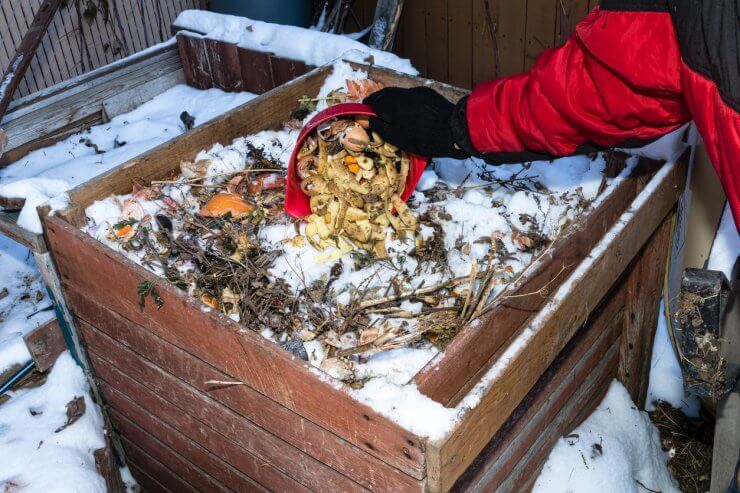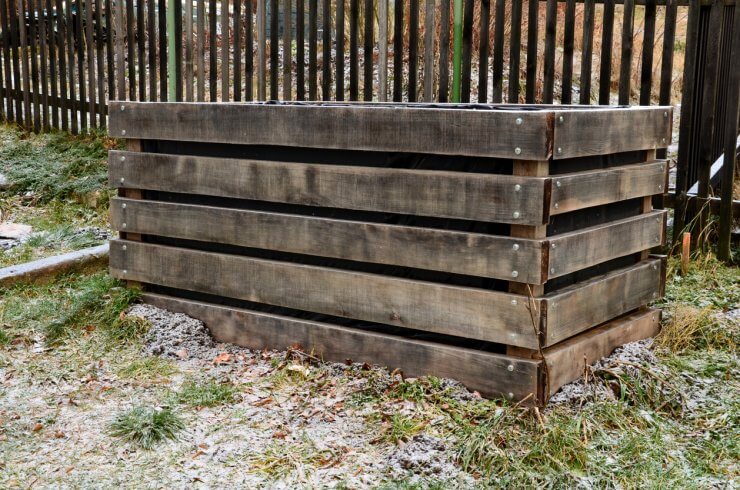
Most of us here at the Food Gardening Network love composting. Composting is a great way to deal with waste, the finished compost is super nutritious for your garden, and you don’t need any special equipment. But since the decomposition process requires heat, can you keep composting in winter? Yes.
Your compost pile won’t move as quickly in the winter, and you may need to do a little extra prep in the fall. Still, there’s no reason to stop composting in winter. Here is a quick-start guide to the process.
Discover 7 top tips for growing, harvesting, and enjoying tomatoes from your home garden—when you access the FREE guide The Best Way to Grow Tomatoes, right now!

The 9 supplies you need for composting in winter
1. A shovel. Because the speed of composting is so slow in the winter, you’ll want to make sure you have plenty of room to add in what may be several months’ worth of kitchen scraps. Before the temperature drops, be sure to remove any ready compost. Then put the shovel away. There is some debate about whether or not you need to turn your pile when you’re composting in winter. However, the extension program at the University of New Hampshire suggests not turning it, as that will “result in heat loss.”
2. Brown material. Whether you already have a compost heap or you’re just starting one, you’ll need to do some prep work in the fall. All those autumn leaves, dead plants, and pine needles in your garden and yard are ideal composting materials that will be hard to find in the winter. Straw, too, is both an excellent addition to a compost pile and a good insulator, which we’ll cover in a minute. However, straw bales may be more difficult to come by in the winter, so stock up now.
3. Smaller material. If you’re adding to your compost pile, try to break down your materials as much as possible. They compost more quickly and easily that way.
4. Bigger heap. In order to decompose, a compost pile needs to reach and maintain an internal temperature in the range of 140-160 degrees Fahrenheit. A small outdoor compost pile is going to have a hard time achieving that. A larger pile provides more insulation and pockets of air so your compost can stay nice and warm – even when you’re composting in winter.
5. Insulation. Again, it’s essential to keep that internal temperature up as much as possible. A layer of insulation can help. Your options may depend on what kind of composting system you have. If you have a large pile, you may need to use straw or cardboard. Snow is also a great insulator.
6. A warm location. If you have a compost bin you can move, either find a sunny area outdoors or bring it into your garage or shed if you can.
7. Water. The four components of compost are carbon, nitrogen, water, and air. Winter winds may very well dry out your compost pile, meaning you may need to add some water. Check closely first, as you don’t want a soggy mess, but if your compost isn’t getting warm and the dry winter air has sucked all the moisture out of your pile. You may need to add a little H2O.
8. Extra leaves or straw. Any brown material is good to have on hand. When spring rolls around, and your pile starts to thaw, it may very well need some dry brown materials to balance all the moisture.
9. Patience. Composting in winter is a very slow activity. All those microbes that are working to break down the material aren’t moving a whole lot. Be patient.
One last bit of advice. If you have trouble with critters getting into your compost, check out How to Keep Animals Out of Compost Bins for some tips on keeping them at bay.
How does your compost do in the winter? Do you have any tips about composting in winter that you’d like to share?
Discover 7 top tips for growing, harvesting, and enjoying tomatoes from your home garden—when you access the FREE guide The Best Way to Grow Tomatoes, right now!




